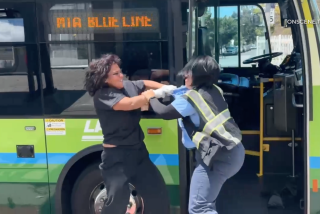RTD’s Driver Hiring Practices Add to System’s Troubles, Experts Say
- Share via
Southern California Rapid Transit District’s method of hiring bus drivers discourages the most responsible applicants and appears to be contributing to the district’s troubles, a panel of transit experts reported Friday.
After three months of studying the RTD’s safety policies and record, the panel also found a long list of shortcomings in driver training, discipline and field supervision, as well as follow-up analysis of accidents. One of the most embarrassing findings was that RTD’s own operating manual for drivers includes basic instructional errors that could cause accidents.
Created by RTD officials in the hope of restoring public confidence in the much-criticized bus system, the seven-member panel of consultants and transit officials from other cities will meet again today to deliver its recommendations to the RTD board.
Question Unanswered
However, the panelists may not answer the question that is on many bus patrons minds: How safe is it to ride the RTD?
Differences in driving conditions in various cities, as well as how various transit agencies collect and report accident data, make comparisons of accident statistics meaningless, panel members said. Likewise, they said, differences in data make it impossible to productively compare RTD’s accident rate to that of the general driving public.
The panelists did say that the RTD’s accident records appear to be accurate and, as independent auditors of RTD have noted, there has been a decline in accidents over the last three years.
One of the panel’s major findings was that the RTD appears to be discouraging the stable, responsible driver applicants it needs most. Under the current agreement with the bus drivers’ union, the only way to get a full-time job as an RTD driver--many of whom can make $30,000 a year or more--is to be hired as a part-time driver and wait two years or more to make it to the top of the part-time seniority list.
66% Fail Exam
Leonard Ronis, a transit consultant and panel member, said that 66% of those taking the RTD’s bus driver examination fail it, which may indicate that the agency is getting low-quality applicants.
Research has shown consistently, Ronis said, that the most reliable and safest transit drivers are those who are married, buying homes and putting children through school--in other words, those in need of well-paying, full-time jobs. But the RTD’s new hires are likely to get the worst routes and fewest hours because assignments are chosen on the basis of seniority.
“If you tell these people they have to take a job for two years that is part-time, they are going to go somewhere else,” Ronis said.
RTD officials withheld immediate comment on most of the panel’s findings, although one acknowledged that limitations on hiring part-time drivers have created problems.
Change May Be Needed
Earl Clark, head of the bus drivers’ union, said the union sought the hiring policy in 1982 because management had been arbitrary in deciding who got jobs. However, he said, a change may be needed because “it’s obvious the district is very limited in its selection” of new drivers.
Other findings by panel members included:
- Disciplinary actions against drivers often are delayed and reversed by appeals to hearing officers. Also, drivers who are “subject to discharge” for acquiring too many demerits are routinely given a second chance.
- New drivers may not be receiving as much behind-the-wheel instruction as necessary because of a shortage of instructors and limits on when equipment may be used. Also, driver operating manuals include instructions--such as turning and stopping procedures--that could cause accidents and injuries.
- Field supervisors, who monitor driver performance, are stretched far too thin and do not themselves have adequate supervision.
- Bus accidents are not always investigated quickly because of a shortage of supervisors and instructors. Also, RTD maintains huge amounts of statistics on accidents, but it does not analyze the data for trends or problems that might be corrected.
More to Read
Sign up for Essential California
The most important California stories and recommendations in your inbox every morning.
You may occasionally receive promotional content from the Los Angeles Times.













